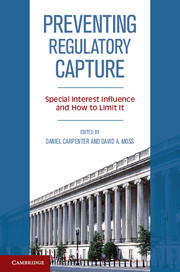Book contents
- Frontmatter
- Contents
- List of Figures
- List of Tables
- Editors
- Contributors
- Preface
- Acknowledgments
- Introduction
- Section I Failures of Capture Scholarship
- 1 A Revisionist History of Regulatory Capture
- 2 The Concept of Regulatory Capture
- 3 Detecting and Measuring Capture
- Section II New Conceptions of Capture – Mechanisms and Outcomes
- Section III Regulatory Case Studies
- Section IV The Possibility of Preventing Capture
- Conclusion
- Afterword
- Index
- References
2 - The Concept of Regulatory Capture
A Short, Inglorious History
Published online by Cambridge University Press: 05 June 2014
- Frontmatter
- Contents
- List of Figures
- List of Tables
- Editors
- Contributors
- Preface
- Acknowledgments
- Introduction
- Section I Failures of Capture Scholarship
- 1 A Revisionist History of Regulatory Capture
- 2 The Concept of Regulatory Capture
- 3 Detecting and Measuring Capture
- Section II New Conceptions of Capture – Mechanisms and Outcomes
- Section III Regulatory Case Studies
- Section IV The Possibility of Preventing Capture
- Conclusion
- Afterword
- Index
- References
Summary
The term regulatory capture, as I use it, refers to the subversion of regulatory agencies by the firms they regulate. This is to be distinguished from regulation that is intended by the legislative body that enacts it to serve the private interests of the regulated firms, for example by shielding them from new entry. Capture implies conflict, and regulatory capture implies that the regulated firms have, as it were, made war on the regulatory agency and won the war, turning the agency into their vassal. That at any rate is how I understand the concept.
The phenomenon of regulatory capture so understood must be as old as regulation itself – it was remarked for example by Woodrow Wilson in 1911 – but it first received sustained attention from political scientists, notably Marver Bernstein. In his book Regulating Business by Independent Commission, Bernstein proposed a “life cycle of regulatory commissions” having four phases: “gestation,” “youth,” “maturity: the process of devitalization,” and “old age: debility and decline.” That misleadingly suggests an internal process, like the life cycle of a human being, who is born, grows, matures, declines, dies – all without having to be attacked and taken over. However, it turns out that Bernstein is describing regulatory capture and not merely regulatory juvenescence and senescence.
- Type
- Chapter
- Information
- Preventing Regulatory CaptureSpecial Interest Influence and How to Limit it, pp. 49 - 56Publisher: Cambridge University PressPrint publication year: 2013
References
- 15
- Cited by

